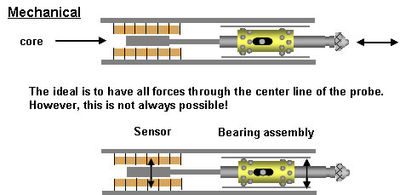
Contact Details:
Ametek Solartron Metrology
915 N. New Hope Rd Sute C
Gastonia
NC
28054
United States of America
Tel: +1 800 873-5838
Fax: +1 704 868-4661
Send Enquiry | Company Information

Understanding Gauging Non-Repeat
Service News Monday, December 31, 2012: Ametek Solartron Metrology
A test that can not be reliably repeated is of little value.
Gauge R&R (repeatability & reproducibility) is one of the most important aspects of a gauging fixture. Good repeatability is one of the most difficult functions to achieve when building a gauging probe, which is why Solartron has invested so much in the Manufacture of Bearings and shielding against electrical interference.
The failure of a Gauging Probe to provide good repeatability comes primarily from two sources, mechanical free movement within the probe and electrical noise.
Determining Non Repeat
It is relatively simple to determine good repeatability from a gauging probe by gently lifting the tip and allowing it to gently return to its start position. A number of probe manufacturers use this method or fail to quote non repeat at all.
Unfortunately, apart from a few laboratory applications, such as Gauge Block Calibration, the vast majority of applications are a lot more demanding.
The method used to determine non-repeat at Solartron Metrology is very demanding but relative to both laboratory and shop floor applications.
A reading is taken with the probe tip resting on a datum point.
The tip is then raised while exerting a side force of 80-100 grm and returned to the start point. A second reading is taken to determine the deviation from the start point.
This process is repeated at the four points of the compass.
The maximum difference in the readings between the four lifting cycles represents non-repeatability.
Understanding Non Repeat - Electrical
Electrical noise or cross talk can have a significant negative effect to both Non Repeat and Accuracy when using any conventional LVDT or Half Bridge Gauging Probe.
Noise levels are often related to the number of probes installed and can have a significant effect on gauge R&R.
Solartron Metrology takes special care to ensure that with its shielded construction, its Analogue Gauging Probesare as immune as possible to external electrical interference. However, as a component no LVDT or Half Bridge Gauging Probe can, on its own, obtain CE certification for noise immunity or emission.
It is the responsibility of the system builder to obtain CE certification for any complete system that incorporates Analogue Gauging probes.
Solartron Metrology’s Orbit® Network and Digital Gauging Probes provide improved Gauge R&R through cleaner signals and better electrical noise immunity:
Solartron Digital Probes Conform to EN 61000-6-2 and have been independently approved for CE certification.
Understanding Non Repeat - Pneumatic Gauging Probes
It is often necessary to use a Pneumatic Push Probe because it’s the only way to avoid side loading or to get the tip to a gauging point.
The lines of force are through the centre line of the probe, which helps to ensure good repeatability and a long life in any gauging application.
Tip force can also have a significant effect on repeatability, particularly in the gauging of fragile components such as glass or electrical components.
The tip force on Pneumatic Gauging Probes can, to a large degree, be controlled by the pressure of the air supply.
The gaiter, which can have a significant effect on tip force, is replaced by a shroud on the AT and DT ranges of probes to ensure very low tip forces.
However, they are unsuitable for use in wet or oily environments.
